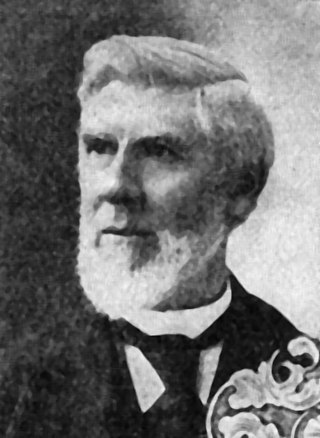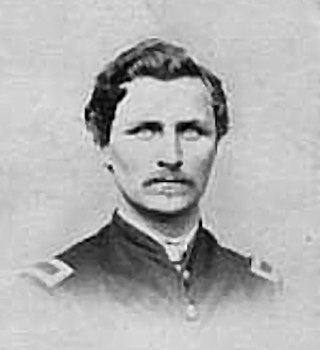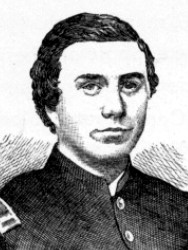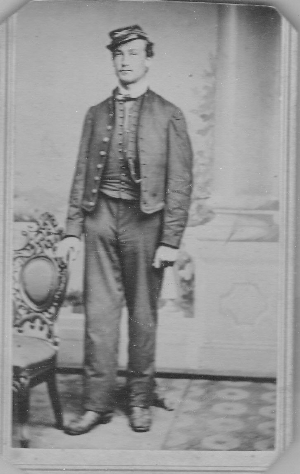
The 1st West Virginia Cavalry Regiment served in the Union Army during the American Civil War. Although it started slowly, it became one of the most active and effective of the West Virginia Civil War regiments—and had 14 Medal of Honor recipients, the most for any West Virginia regiment during the war. It was originally called the 1st Virginia Cavalry, not to be confused with the Confederate 1st Virginia Cavalry. Some reports added "Union," "Loyal" or "West" when identifying this regiment. After the Unionist state of West Virginia was officially admitted to the Union in 1863, the regiment became the 1st West Virginia Cavalry Regiment. The National Park Service identifies it as the 1st Regiment, West Virginia Cavalry.

Charles Veale or Veal was an African American Union Army soldier during the American Civil War and a recipient of America's highest military decoration—the Medal of Honor—for his actions at the Battle of Chaffin's Farm.
Frederick Charles Anderson was a Union Army soldier in the American Civil War who received the United States military's highest decoration, the Medal of Honor. Born in Boston, Massachusetts, and orphaned at a young age, Anderson was adopted by a farming family in rural Raynham. He enlisted in the Union Army shortly after the start of the war and, as a private in the 18th Regiment Massachusetts Volunteer Infantry, participated in several major battles, including Antietam, Fredericksburg, Chancellorsville, and Gettysburg. He was awarded the Medal of Honor for capturing a Confederate battle flag during the Battle of Globe Tavern on August 21, 1864. Transferred to the 32nd Regiment Massachusetts Volunteer Infantry and wounded in the Siege of Petersburg, he returned to the field in time to witness the Confederate surrender at Appomattox Court House. After the war, he returned to Massachusetts, working and raising a family until his sudden death at age 40.

Richard H. Cosgriff, Sr., was a Union Army soldier in the American Civil War and a recipient of the United States military's highest decoration, the Medal of Honor. An Irish immigrant, his family eventually settled in Wisconsin, where he would spend most of the rest of his life. Enlisting in an Iowa cavalry regiment, he was awarded the Medal of Honor for capturing a Confederate battle flag during an engagement in the last month of the war. After returning to Wisconsin, he worked as a businessman in the lumber and printing industries until his death at age 64.

Henry M. Fox was a Union soldier during the American Civil War, and a Medal of Honor recipient.

Charles H. Marsh was a Union Army soldier in the American Civil War and a recipient of the United States military's highest decoration, the Medal of Honor, for his actions during a skirmish in the Valley Campaigns of 1864.

Eri Davidson Woodbury was a Union Army officer during the American Civil War. He received the Medal of Honor for gallantry during the Battle of Cedar Creek fought near Middletown, Virginia on October 19, 1864. The battle was the decisive engagement of Major General Philip Sheridan’s Valley Campaigns of 1864 and was the largest battle fought in the Shenandoah Valley.
Thomas A. Anderson was a United States soldier and native of Pennsylvania who fought with the Union Army as a corporal in Company I of the 1st West Virginia Cavalry during the American Civil War. He was awarded his nation's highest award for valor, the U.S. Medal of Honor, for capturing the flag of a Confederate regiment during the Battle of Appomattox Station on April 8, 1865. The award was conferred on May 3 of that same year.

William Wirt Winegar was a Union Army officer during the American Civil War. He received the Medal of Honor for gallantry during the Battle of Five Forks fought on April 1, 1865 southwest of Petersburg, Virginia. The battle was part of the Appomattox Campaign and was a victory for Union forces under Maj. Gen. Philip H. Sheridan over Confederate Maj. Gen. George E. Pickett.
Private Warren C. Dockum was an American soldier who fought in the American Civil War. Dockum received the country's highest award for bravery during combat, the Medal of Honor, for his action during the Battle of Sayler's Creek in Virginia on 6 April 1865. He was honored with the award on 10 May 1865.
Private Coron D. Evans was an American soldier who fought in the American Civil War. Evans received the country's highest award for bravery during combat, the Medal of Honor, for his action during the Battle of Sayler's Creek in Virginia on 6 April 1865. He was honored with the award on 3 May 1865.

Sergeant Charles Henry Fasnacht was an American soldier who fought in the American Civil War. Fasnacht received the country's highest award for bravery during combat, the Medal of Honor, for his action during the Battle of Spotsylvania Court House in Virginia on 12 May 1864. He was honored with the award on 2 April 1878.
Sergeant John P. Donaldson was an American soldier who fought in the American Civil War. Donaldson received the country's highest award for bravery during combat, the Medal of Honor, for his action during the Battle of Appomattox Courthouse in Virginia on 9 April 1865. He was honored with the award on 3 May 1865.

James Henry Gribben was an American soldier who fought in the American Civil War. Gribben received his country's highest award for bravery during combat, the Medal of Honor. Gribben's medal was won for capturing the flag of the Confederate 12th Virginia Infantry at the Battle of Sayler's Creek in Virginia on April 6, 1865. He was honored with the award on May 3, 1865.

Joseph A. Kimball was an American soldier who fought in the American Civil War. Kimball received his country's highest award for bravery during combat, the Medal of Honor. Kimball's medal was won for his capturing the flag of the Confederate 6th North Carolina Infantry at the Battle of Sailor's Creek in Virginia on April 6, 1865. He was honored with the award on May 3, 1865.

Rudolph Romeo Riddell was a Lieutenant in the United States Army who was awarded the Medal of Honor for gallantry during the American Civil War. On 6 April 1865, Riddell captured the flag of the 6th Alabama Cavalry of the Confederate Army. For this action, he was awarded the Medal of Honor on 10 May 1865.
Bernard Shields was a private in the United States Army who was awarded the Medal of Honor for gallantry during the American Civil War. He was awarded the medal on 3 May 1865 for actions performed at the Battle of Appomattox Station in April 1865.

Charles Schorn was a bugler in the United States Army who was awarded the Medal of Honor for gallantry during the American Civil War. Schorn was awarded the medal on 3 May 1865 for actions performed at the Battle of Appomattox Courthouse on 8 April 1865.
Edwin F. Savacool was a captain in the United States Army who was awarded the Presidential Medal of Honor for gallantry during the American Civil War. He was awarded the medal on April 24, 1865, for actions performed at the Battle of Sailor's Creek in Virginia on April 6, 1865.









